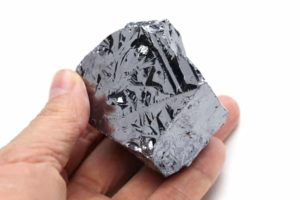
Ore Minerals
An ore is a natural occurrence of rock or sediment which contains enough minerals with economically important elements, typically metals, that can be extracted from the deposit economically. The ores are extracted by mining for a profit from the earth; they are then refined (often by smelting) in order to extract the valuable elements.
The ore quality, and density of a rock or metal ore, as well as its occurrence type, can directly affect the ore mining costs. It is therefore necessary to weigh the extraction cost against the metal value contained in the rock to determine which ore can be processed and which ore is too low a grade to be worth mining.
Metal ores are generally oxides, sulfides, silicates, or native metals (such as native copper) not commonly concentrated in the crust of the Earth, or noble metals (normally not forming compounds) such as gold. To remove the elements of interest from the waste material and the ore crystals, the ores must be extracted. A variety of geological processes form ore bodies. The formation of the ore process is called the genesis of the ore.
Classification of Ore Minerals
Ore Mineral deposits are categorized according to different criteria that have been established through the study of economic geology or mineral genesis. Typical are the classifications below.
Hydrothermal epigenetic deposits
- Mesothermal lode gold deposits, typified by the Golden Mile, Kalgoorlie
- Archaean conglomerate hosted gold-uranium deposits, typified by Elliot Lake, Ontario,
- Canada and Witwatersrand, South Africa
- Carlin–type gold deposits, including;
- Epithermal stockwork vein deposits
Granite related hydrothermal
- IOCG or iron oxide copper gold deposits, typified by the supergiant Olympic Dam Cu-Au-U deposit
- Porphyry copper +/- gold +/- molybdenum +/- silver deposits
- Intrusive-related copper-gold +/- (tin-tungsten), typified by the Tombstone, Arizona deposits
- Hydromagmatic magnetite iron ore deposits and skarns
- Skarn ore deposits of copper, lead, zinc, tungsten, etcetera
Magmatic deposits
- Magmatic nickel-copper-iron-PGE deposits including
– Cumulate vanadiferous or platinum-bearing magnetite or chromite
– Cumulate hard-rock titanium (ilmenite) deposits
– Komatiite hosted Ni-Cu-PGE deposits
– Subvolcanic feeder subtype, typified by Noril’sk-Talnakh and the Thompson Belt, Canada
– Intrusive-related Ni-Cu-PGE, typified by Voisey’s Bay, Canada and Jinchuan, China - Lateritic nickel ore deposits, examples include Goro and Acoje, (Philippines) and Ravensthorpe, Western Australia.
Volcanic-related deposits
- Volcanic hosted massive sulfide (VHMS) Cu-Pb-Zn including;
Examples include Teutonic Bore and Golden Grove, Western Australia
– Besshi type
– Kuroko type
Metamorphically reworked deposits
- Podiform serpentinite-hosted paramagmatic iron oxide-chromite deposits, typified by Savage River, Tasmania iron ore, Coobina chromite deposit
- Broken Hill Type Pb-Zn-Ag, considered to be a class of reworked SEDEX deposits
Carbonatite-alkaline igneous related
- Phosphorus-tantalite-vermiculite (Phalaborwa South Africa)
- Rare earth elements – Mount Weld, Australia and Bayan Obo, Mongolia
- Diatreme hosted diamond in kimberlite, lamproite or lamprophyre
Sedimentary deposits
- Banded iron formation iron ore deposits, including
– Channel-iron deposits or pisolite type iron ore - Heavy mineral sands ore deposits and other sand dune hosted deposits
- Alluvial gold, diamond, tin, platinum or black sand deposits
- Alluvial oxide zinc deposit type: sole example Skorpion Zinc
Sedimentary hydrothermal deposits
- SEDEX
– Lead-zinc-silver, typified by Red Dog, McArthur River, Mount Isa, etc.
– Stratiform arkose-hosted and shale-hosted copper, typified by the Zambian copperbelt.
– Stratiform tungsten, typified by the Erzgebirge deposits, Czechoslovakia
– Exhalative spilite-chert hosted gold deposits - Mississippi valley type (MVT) zinc-lead deposits
- Hematite iron ore deposits of altered banded iron formation
Astrobleme-related ores
- Sudbury Basin nickel and copper, Ontario, Canada
Ore Extraction
The basic extraction of ore deposits follows these steps:
- Prospecting or exploration to find and then define the extent and value of ore where it is located (“ore body”)
- Conduct resource estimation to mathematically estimate the size and grade of the deposit
- Conduct a pre-feasibility study to determine the theoretical economics of the ore deposit. This identifies, early on, whether further investment in estimation and engineering studies is warranted and identifies key risks and areas for further work.
- Conduct a feasibility study to evaluate the financial viability, technical and financial risks and robustness of the project and make a decision as whether to develop or walk away from a proposed mine project. This includes mine planning to evaluate the economically recoverable portion of the deposit, the metallurgy and ore recoverability, marketability and payability of the ore concentrates, engineering, milling and infrastructure costs, finance and equity requirements and a cradle to grave analysis of the possible mine, from the initial excavation all the way through to reclamation.
- Development to create access to an ore body and building of mine plant and equipment
- The operation of the mine in an active sense
- Reclamation to make land where a mine had been suitable for future use
Examples of Ore Minerals
- Acanthite (cooled polymorph of Argentite): Ag2S for production of silver
- Barite: BaSO4
- Bauxite Al(OH)3 and AlOOH, dried to Al2O3 for production of aluminium
- Beryl: Be3Al2(SiO3)6
- Bornite: Cu5FeS4
- Cassiterite: SnO2
- Chalcocite: Cu2S for production of copper
- Chalcopyrite: CuFeS2
- Chromite: (Fe, Mg)Cr2O4 for production of chromium
- Cinnabar: HgS for production of mercury
- Cobaltite: (Co, Fe)AsS
- Columbite-Tantalite or Coltan: (Fe, Mn)(Nb, Ta)2O6
- Dolomite: CaMg(CO3)2
- Galena: PbS
- Native gold: Au, typically associated with quartz or as placer deposits
- Hematite: Fe2O3
- Ilmenite: FeTiO3
- Magnetite: Fe3O4
- Malachite: Cu2CO3(OH)2
- Molybdenite: MoS2
- Pentlandite: (Fe, Ni)9S8
- Pyrolusite: MnO2
- Scheelite: CaWO4
- Sperrylite: PtAs2 for production of platinum
- Sphalerite: ZnS
- Uraninite (pitchblende): UO2 for production of metallic uranium
- Wolframite: (Fe, Mn)WO4










